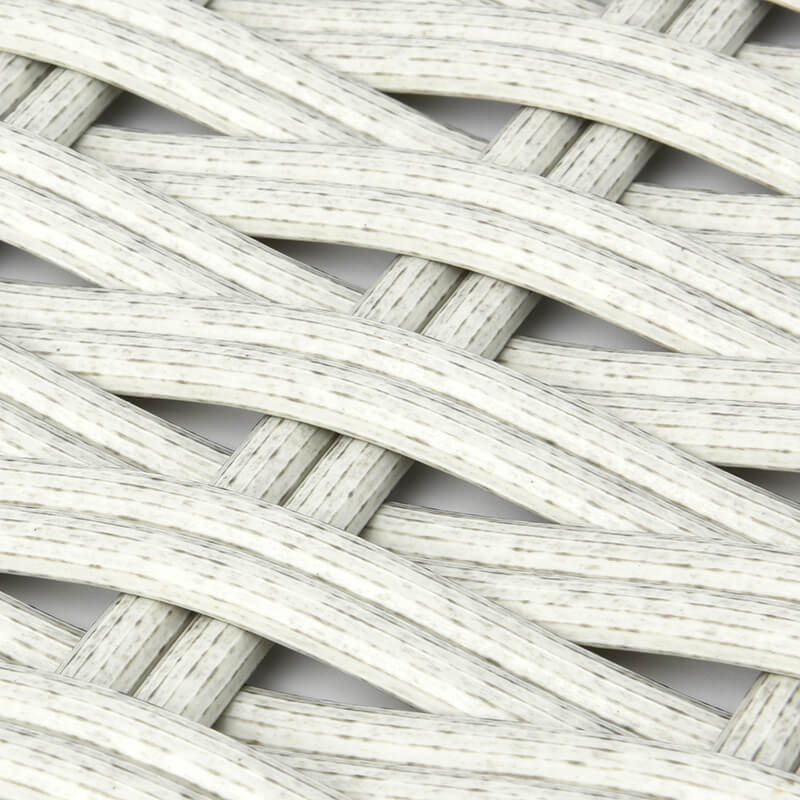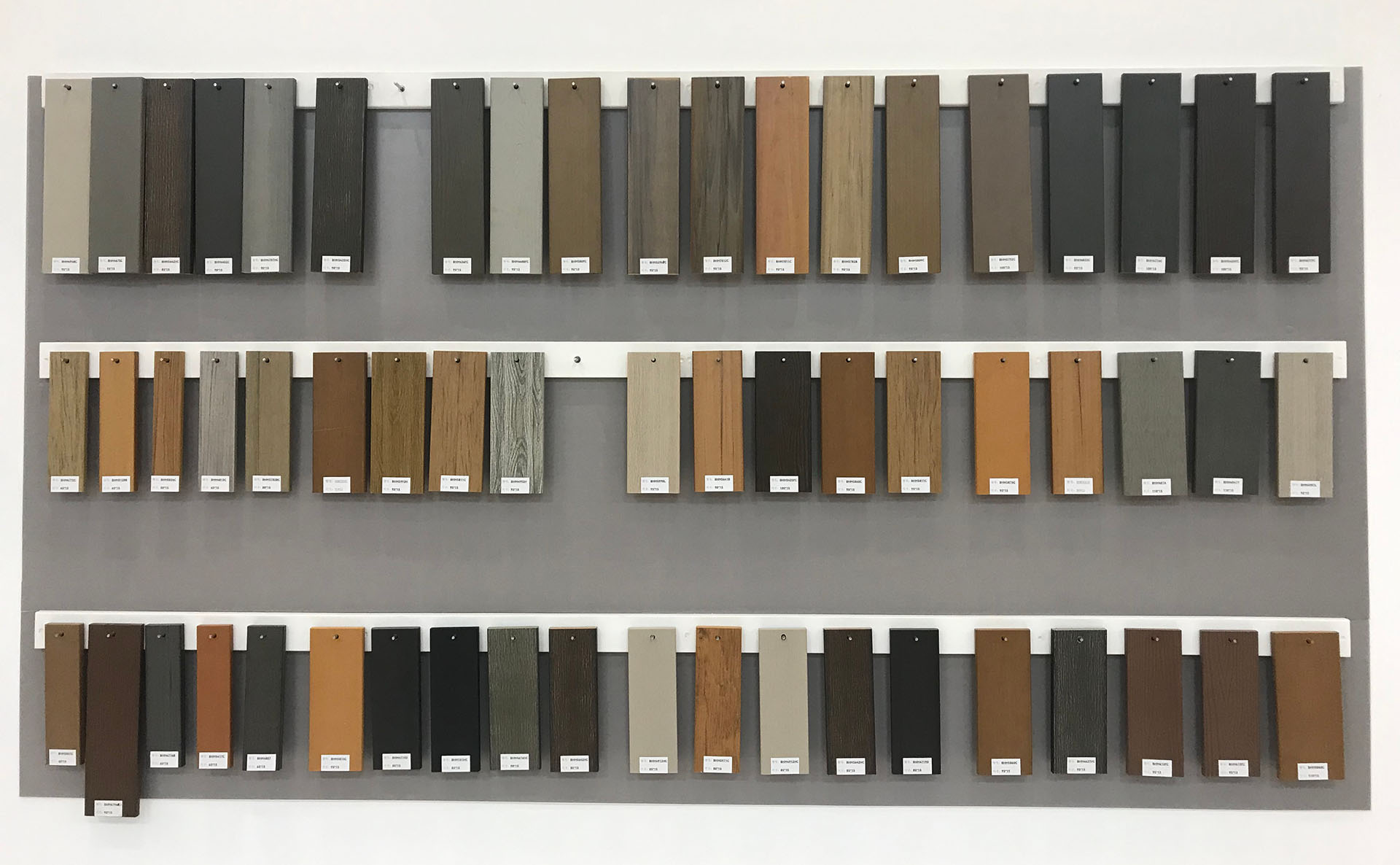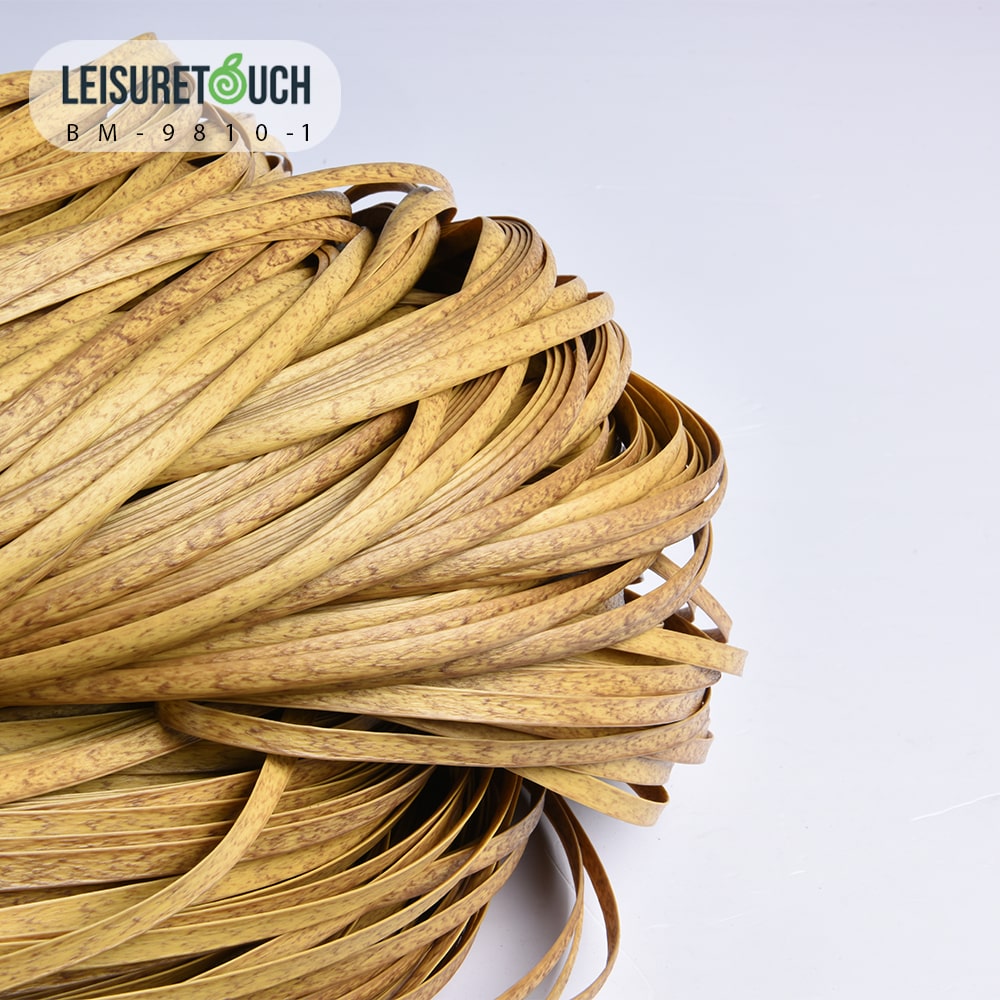The Increasing Demand for Synthetic Rattan Material
In recent years, the demand for outdoor furniture that seamlessly blends style, durability, and environmental consciousness has surged. Among the materials meeting these criteria, synthetic rattan has emerged as a frontrunner. It is a kind of sustainable outdoor material that helps preserve the natural environment. Outdoor furniture that is made of synthetic rattan is one of the most popular choices for lots of people.
No matter if you are walking in a park, a commercial lounge area, or a private garden, the presence of plastic rattan furniture has increased a lot and replaced traditional real rattan and real wood furniture because of its multiple advantages. However, some people might still be confused about synthetic rattan, in the following paragraphs; I will provide you a comprehensive guide about synthetic rattan.

What Is Synthetic Rattan?
Just like the name suggests, synthetic rattan is not real rattan. It is a kind of artificial material that highly imitates the natural appearance of real rattan. It is also called plastic rattan, PE rattan and artificial rattan by people. In general, plastic rattan can be divided into three major types, such as PE rattan, PVC rattan and PU rattan. Among these three types, PE rattan is the one that showcases the best quality since the raw materials that are used in the production of PE rattan are more premier and durable.
In this article, we will focus on a specific type of synthetic rattan: PE rattan. It is a man-made and sustainable material that is entirely made of plastics such as HDPE, PVC, and other additives such as pigments, antioxidants, anti-UV agents and light stabilizers. During the manufacturing process, exquisite craftsmanship will be applied to craft excellent plastic rattan with the natural grains and texture of real rattan, making it highly similar to natural rattan material. Specifically, HDPE stands for high-density polyethylene and PVC stands for polyvinyl chloride.
These two types of plastics are recyclable and can be recycled, melted and reformed into new products when they reach the end of their lifespan, which largely minimizes the damage to the environment caused by plastic products. As a popular outdoor furniture material, it is sturdy, durable and can undergo changing outdoor weather conditions, securing you a carefree and comfortable outdoor space.

Differences between Rattan and Wicker
Apparently, this problem is one of the most commonly asked questions by people when they come to select rattan furniture for their outdoor spaces since many people will mess up the conceptions of rattan and wicker together. Normally, the terms rattan and wicker are often used interchangeably by people, but they are totally different. Rattan refers to different materials and wicker is a type of weaving method in the manufacturing process.
Rattan material can be natural rattan or synthetic rattan. Natural rattan is derived from the stems of a palm-like plant, typically found in Southeast Asia. It is known for its flexibility, strength, and durability. On the other hand, wicker refers to the weaving technique that is used to create furniture pieces, which can be made from a variety of materials, including rattan, bamboo, willow, reed, or synthetic fibres. Therefore, while all rattan furniture is wicker, not all wicker furniture is made from rattan. If you only want outdoor furniture that is made of synthetic rattan or natural rattan, remember to pay attention to the selection processes.

Natural Rattan and Synthetic Rattan
Natural rattan and synthetic rattan are two distinct materials that are popular in the furniture industry and have their own special characteristics and benefits. According to what I mentioned above, natural rattan is derived from the real rattan palm plant which has its original and natural rattan appearance. On the other hand, synthetic rattan is a kind of artificial material that is 100% made of plastics and other additives, which is recyclable, durable and closely mimics the real grains, texture and patterns of natural rattan. Although natural rattan has more original and traditional charms compared with plastic rattan, it does require regular cleaning and maintenance of people as it has a worse capacity to survive in outdoor settings where the weather is unpredictable.
By contrast, furniture that is made of synthetic rattan is easier to maintain and requires minimal care of people since it is resistant to sunlight, moisture, fading, changing temperatures and pests, making it suitable for outdoor use. Additionally, since synthetic rattan is a type of artificial material, it has a better customisation option for its designs, colours and patterns, allowing it to suit various aesthetic preferences and design schemes. Overall, while natural rattan is superior in its classic elegance, plastic rattan showcases better functionality, durability, and easy maintenance, making it a preferred choice for modern outdoor furniture.

Benefits of Synthetic Rattan
Before we talk about the benefits of plastic rattan, we can first answer a question that many people are asking. That is, can plastic rattan furniture be left outdoors? The answer is yes. As one of the most popular materials for outdoor furniture manufacturing, synthetic rattan has lots of benefits which make it resistant to various outdoor situations such as storms, snow, sunlight and so on. Let’s learn more about the benefits of synthetic rattan to craft more furniture with excellent quality.
Exquisite Appearance
Synthetic rattan is not only famous for its high quality and excellent durability of being outdoors, but it is also outstanding because of its exquisite appearance. When LTR produces plastic rattan, professional manufacturing processes are involved to craft out the most beautiful synthetic rattan with natural grains, patterns and texture of real rattan, making it a similar look to real rattan and popular for most outdoor furniture lovers.
Waterproof
As a type of outdoor material that is entirely made of plastics, it does not contain any natural ingredients inside. As a result, it is not sensitive to water and humidity; and will not rot or break due to the high humidity, making it a suitable material for outdoor furniture that will be placed around the water source such as in poolside areas, coastal areas, humid areas and so on.
Weather-proof
Weatherproof is one of the most outstanding advantages of synthetic rattan. Because of this characteristic, it can survive in outdoor settings for a long time. Its strong ability to withstand harsh weather conditions makes it resistant to strong direct sunlight, heavy rain and heavy wind. Even though the rattan furniture will be placed outdoors without any covers; it will not be damaged easily by these natural elements because of the additives added.

Durable
Compared to other outdoor furniture materials such as natural rattan, natural wood, aluminium, steel, and so on, PE rattan has a relatively longer lifespan of around 5 years if they are all used in outdoor furniture manufacturing. As the major ingredient of PE rattan, high-density polyethene plays a significant role in the high quality of the synthetic rattan.
Low Maintenance
Plastic rattan furniture is a worthy long-term investment in your garden or patio since it is strong enough to withstand the various weather conditions outdoors. It does not need regular cleaning and maintenance of people. If there are some stains on it, a soft cloth with warm water can be used to clean it, which is easy and convenient for people.
Eco-friendly & Non-toxic
Unlike natural rattan which is derived from natural plants, plastic rattan is totally made of recyclable plastics. Synthetic rattan material can be collected, melted and reformed to be new products when it comes to the end of its life, which brings no harm to the earth.
Inexpensive
Synthetic rattan is not a type of costly outdoor material since its price is relatively lower than natural rattan, natural wood and other metal materials. The price for a set of plastic rattan furniture costs around $500 while a set of natural rattan or metal furniture costs above $800. What is more, except for its initial price, synthetic rattan is cost-effective since it does not need additional care and maintenance of people.

Diverse & Customizable
As a kind of man-made material, synthetic rattan offers a wide range of customisable options such as colours, shapes, patterns and textures. If you want some high-quality plastic rattan materials with incredible craftsmanship, contact us now for more details.
Comfortable Sitting
When synthetic rattan is used in furniture making, it is normally crafted by a special weaving technique. The tiny gaps between the rattans make the whole furniture breathable. What is more, with the waterproof function, when you sit on a plastic rattan chair, you will not feel uncomfortable because of the sweltering heat caused by humidity and decay.
Wide Range of Application
Although many people think that rattan material is a traditional and old-fashioned furniture material, the diversification of rattan material and advanced technology have elevated rattan furniture to a higher level. It can be crafted into different furniture and decorations, and can also be perfectly integrated into various spaces with different styles.
How Is Synthetic Rattan Made?
High-quality, exquisite and durable outdoor rattan furniture cannot be separated from high-quality plastic rattan material. Only the plastic rattan that passes through sophisticated production processes will have an excellent quality and aesthetic look. In this paragraph, I will briefly introduce LTR’s manufacturing processes of PE rattan so that you will understand how this material is made.
1. Material Preparation
In this initial step, high-quality raw materials such as HDPE and other additives are mixed together and added into the machines according to LTR’s pre-set ratio, ensuring a strong foundation for the final product.

2. Extrusion Step
Raw materials are then processed through extrusion machines, where they are heated and formed into continuous strands so that they can be manufactured into different shapes easily in the following step.
3. Moulding and Formation
Now, custom moulds are used to shape the extruded strands from the last step. Detailed patterns of the rattan which highly imitate the grains and texture of natural rattan are crafted here, adding additional aesthetics to the final product.
4. Cooling and Solidification
In this process, plastic rattan needs to be solidified by a rapid cooling system so that the desired shape and design of the pattern can be maintained, which is essential for the product’s consistency and quality.
5. Embossing
The embossed strands are created using specialized machinery, making the plastic rattan look more real and have a more natural appearance, which effectively enhances its visual effect.

6. Rolling and Coiling
The strands are then rolled and coiled for efficient handling and transportation so that they are well prepared for the future stages of further production and eventual distribution.
7. Final Packaging
The last step is to carefully package the completed plastic rattan in order to ensure that it can be safe in the shipping process and arrive at the destination in its best state.
Popular Types of Synthetic Rattan
Unlike natural rattan, synthetic rattan is totally a type of man-made material which can be manufactured into various types of rattan with customisable shapes, patterns, grains and textures. Here are seven types of rattan that are commonly used in outdoor furniture making.
This type of synthetic rattan has a smooth and flat surface. It looks like nearly straight lines on both sides of the rattan. Because of its simple but beautiful appearance, it is commonly used by people in furniture crafting. Its smooth texture makes it easy to shape and weave into stylish furniture pieces.
The interior of round synthetic rattan is in a circular form which is ideal for seat covers, chairs, and baskets since it is sturdy. The round collection not only adds an appealing aesthetic to your outdoor furniture but also enhances its capacity to support weight, ensuring comfortable seating and a robust furniture structure.

Just like the name suggests, this type of rattan is produced in the shape of a half-moon which is fashionable and cute, effortlessly offering a sense of beauty to your garden area.
This kind of plastic rattan is elastic and flexible compared to other types of rattan. It imitates the appearance, shape and pattern of real sea grass and showcases an original and natural feeling. This rattan is more suitable for decoration making since it is not that strong to hold much weight.
The twisted rattan collection can be made of seagrass rattan or other types of rattan. It is similar to other normal plastic rattan but with an additional twisting process, which is natural and soft.
With its unique design, this rattan closely resembles an authentic rope, mimicking the appearance of real strands with precision.

Fusion of Half-Moon with Flat Rattan
This design combines both flat rattan and half-moon design together, providing a novel and avant-garde option for people to choose from, which is suitable for both indoor and outdoor settings.
How to Clean Plastic Rattan Furniture?
Although plastic rattan furniture does not need too much attention and maintenance of people, proper cleaning can help retain the aesthetic appeal of the outdoor furniture. Here are some useful tips that you might need.
1. Mix some warm water with a mild detergent to create a gentle solution. Remember not to use foaming cleaner to clean the rattan furniture, as it will leave residue on the furniture.
2. Then, use a soft sponge to gently wipe down the dirt accumulated over time on the surface of the rattan furniture.
3. For more stains that are difficult to remove, you can use a soft brush to clean them again.
4. When you scrub the affected areas, please remember not to do it too hard since it will damage the aesthetic appearance of the rattan furniture.
5. Lastly, rinse the furniture thoroughly with clean water so that the residual soap or detergent can be removed. After that, you can gently dry it with a soft rag or let it dry in natural weathering.

We Can Offer You the Unique and High-quality Synthetic Rattan
Leisure Touch Rattan is a Chinese supplier that has been dedicated to producing high-quality plastic rattan and plastic wood for decades. In order to cater to the various needs of our valued customers, we always use the latest technology to craft out synthetic rattan that has the best natural appearance of real rattan. With a wide range of moulds and testing machines in our factory, we tailor our plastic rattan products to your exact specifications while maintaining the highest standards of quality. By selecting Leisure Touch Rattan, your outdoor area can reach the next level with stylish and comfortable outdoor furniture.
Conclusion
In conclusion, synthetic rattan has emerged as a versatile and durable alternative to natural rattan, offering lots of benefits for outdoor furniture applications. It is mainly made of recyclable plastics- polyethylene, which is sturdy, durable, eco-friendly and resistant to harsh outdoor situations, making it become one of the most popular materials for outdoor furniture. After reading this article, you have already gained a deeper knowledge about synthetic rattan by knowing the manufacturing processes, various types and extensive advantages of plastic rattan. Overall, synthetic rattan stands as a testament to innovation and sustainability in outdoor furniture design, enhancing outdoor living spaces with its beauty and practicality. If you would like to gain more details about LTR’s plastic rattan, click here for more information!









